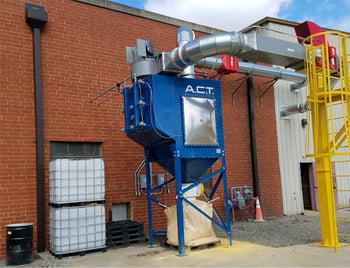 The purpose of an industrial dust collector is to create a more efficient operating process and a safer space to work. And while this is true for any organization who installs one, there’s always the possibility of a malfunction or inefficiency taking place. When that happens, you need a dust collector troubleshooting guide.
The purpose of an industrial dust collector is to create a more efficient operating process and a safer space to work. And while this is true for any organization who installs one, there’s always the possibility of a malfunction or inefficiency taking place. When that happens, you need a dust collector troubleshooting guide.
At A.C.T. Dust Collectors, it’s our goal to respond quickly when customers need assistance in answering questions and to provide the proper equipment when they run into common dust collector issues. Learn about the five most common dust collector problems customers face and how to troubleshoot them in this guide.
Five of the Most Common Dust Collector Issues and How to Solve Them
1. Problem: Industrial Air Filter Systems With Little or No Suction
Is your industrial dust collector not pulling in contaminated air as strongly as it should? There are several reasons for this. The first question we ask our customers experiencing this issue is, “how old and how dirty are your current filters?” If you haven’t replaced your air filters in a while, this could be one reason for less suction. This is an easy fix – simply replace your current filters. (Find replacement ACT dust filters.)
Another reason for poor suction in your industrial air filter system is backwards fan rotation. If your fan is spinning backward (on A.C.T. systems you’ll easily be able to tell by the arrow symbols near the fan), this means the dust collector motor is wired improperly. You’ll know if this is the culprit if you’re noticing your machine is running at about half capacity and it will also be twice as noisy. You can also refer to the rotation arrow symbol showing the correct spinning direction, located on all fans. This, too, is not a complicated fix. Check your power supply. If two out of the three legs of your power supply are reversed, the fan will spin backwards. Just switch them up to get the correct rotation and optimum performance.
Lastly, there may be too much resistance in your filtration system taking place in your ductwork. This occurs if ductwork is not set up efficiently, it has too many tight angles, closed slide gates or the ductwork is simply too small for your industrial dust collector. To check your resistance, take a pressure gauge and attach it to your ductwork. This is far less common of a reason for poor suction taking place, but it’s always good to check just in case. It’s important to keep in mind that ideal flow rates for dust collectors will vary by particulate. Heavy particulate will require faster transport velocity.
In this scenario, it’s common to think you have the wrong dust collector. While this can happen, there’s a chance you have the right collector, just accompanied by the wrong duct design.
To avoid this situation, our experts at A.C.T. will examine ductwork design before installing your dust collection system. We’ll also offer to help with duct sizing, fan operation and filter recommendations.
2. Problem: Particulate Bypassing Air Filter
If particulate is bypassing your air filters this means your filter is not capturing fine particulate and therefore, particulate is passing through into the airspace of your facility and defeating the purpose of your air filtration system. Here’s some professional insight: A filter actually becomes more efficient over time, so if it’s brand new, this may be one reason why particulate isn’t getting caught. The quick and proven solution? Let the dust collector run for a day or so to monitor results.
Bypass could also be taking place because you have the wrong filter installed. At A.C.T., our dust collectors come with the most efficient filter for your specific system setup and needs. Whenever you need to replace that filter, don’t sacrifice quality for price. Buy a genuine A.C.T. filter instead.
Another reason particulate is passing through your filter is because the particulate itself may be too fine. To troubleshoot this issue, you can install a secondary set of filters in the ductwork – like HEPA filters – along with your primary A.C.T. system.
Finally, bypass can also happen as a result of a hole in a filter or the flattening of door gaskets. Filters do break down over time, so replace it right away if you see a hole. You’ll know if your filter isn’t collecting enough dust because you’ll be able to see it coming out of the machine’s exhaust fan, notice dust settling on surfaces in your facility, or even through taste and smell. Our Nano-Elite filters are the most efficient in the market and provide complete customer satisfaction. Door gaskets also flatten out over time, meaning the doors will not seal as tightly. Be sure to check and reach out to an A.C.T. expert for assistance in fixing.
3. Problem: Consistently Clogged Filters
Just as filter bypass can occur, so too can clogging. When this takes place, it means there is a sizing issue. Most likely, your dust collector is too small for your application needs. To solve this problem, give our team a call. We’ll be able to recommend the properly sized machine. As a rule of thumb, the more filter surface area you have, the better your filter life will be.
4. Problem: Zero-Pressure Differential Reading From The Air Filtration System
Sometimes, when a customer originally sets up their dust collector, powers it on, and tests air flow they’ll get a zero pressure differential reading on their gauge. This reading is a measure of how dirty your filters are, but should never be at zero, even with brand-new filters. You’ll need this to work properly in order to determine filter performance. This happens when the two connections between the dust collector’s dirty air side and clean air side are switched. To solve the problem, simply switch the tube connections around.
5. Problem: Air Filtration System Is Not Pulsing
If your industrial dust collector is not pulsing when started up, this means it was not properly wired in the field. Since our industrial dust collection systems do not come pre-wired, we always recommend contacting a certified electrician to properly wire your system.
There’s no need to panic when any of the above problems arise with your industrial dust collector – especially when you have the peace of mind that an A.C.T. expert will guide you to troubleshooting yourself or that we’ll personally come out quickly to troubleshoot your industrial air filtration issues provide a solution.
To learn more about troubleshooting solutions for your industrial dust collector, visit our resources page or contact us with your concerns.


























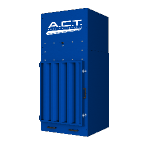
%20Collectors%20Image.png?width=143&height=143&name=ADC%20(Ambient)%20Collectors%20Image.png)
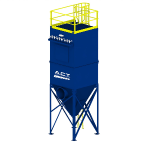

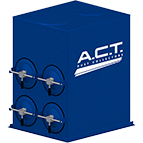
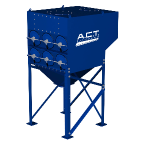
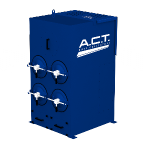


















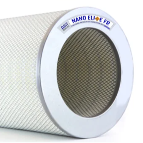


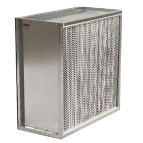
.png?width=240&height=91&name=ACT%20Dust%20Collectors%20Logo%20Solid%20White%202020%20(1).png)
.png?width=148&height=149&name=usa-manufactured-dust-collectors%20(1).png)